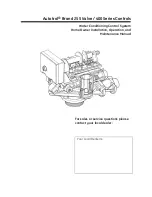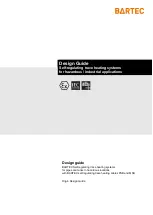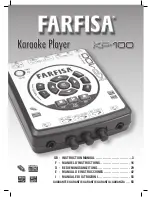
7.3.
OPPOSED SPOT WELDING
The parameters which determine the diameter and the strength of a spot weld are:
1. The clamp force of the electrodes.
2. The electrode face diameter.
3. Welding current and welding time.
Select the appropriate sheet thickness with key 8 and the welder will automatically select the
optimum weld time. This selected time may be adjusted, by key 7 if necessary.
For example: If low voltage supply LED is on, the weld time might
need to be increased slightly.
If sheets of 0.8 to 1.2mm thick and with a high yield point have to be welded, switch to the pulsation welding ( ) mode.
The pulsation cycle is automatically controlled and requires no user input.
IMPORTANT:
A spot weld is considered satisfactory if, when subjected to a tensile stress test, the spot wild is torn from one of the
sheets without any separation in the weld itself.
7.4.
MANUAL CLAMPS
Place the lower electrode on the sheet to be welded. Operate clamping lever, giving:
a) Clamping of the sheets between the electrodes with a pre-adjusted clamp force.
b) A pre-set welding current for the pre-set time. Welding is indicated by the illumination of the green LED
Release the clamp lever
a few moments after
the LED goes out. This delay in releasing the clamp load improves the mechanical
strength of the weld.
7.5.
PNEUMATIC CLAMP
Place one electrode on the surface to be welded.
Operate push-button, giving:
Clamp of the sheets between the electrodes with a pre-set clamp force.
A pre-set welding current for a pre-set time.
Welding is indicated by the green LED
When the LED goes out wait a few moments before releasing clamp. This delay gives an improved weld.
Operate pneumatic clamp with a regulated air supply of 4 to 8 bar.
7.6.
HOW TO USE THE STUDDER.
To assemble or disassemble electrodes use two hex wrenches, one to prevent the clamp spindle rotating and the other to loosen the
clamp nut.
When working on hinged panels, doors, bonnets, tail gates ensure that the ground cable is attached to the work panel rather than to
the vehicle body, so that current does not pass through the hinges.
7.7.
HOW TO CONNECT THE GROUND CABLE.
a) Base sheet area must be at least as big as the ground bar contact area, and should be as near as possible to the welding area.
b1) Fasten the copper ground bar to the sheet with an articulated clamp (welding type) or -
b2) Spot weld a washer (part of kit) to the surface of the sheet, pass the washer through the opening in the ground bar and lock it
using the appropriate clamp supplied.
7.8.
SPOT WELDING WASHER TO FASTEN GROUND BAR.
Mount the special electrode (fig 7. 9) on the clamp spindle and insert washer (fig 7.13).
Position washer on chosen ground area and contact ground terminal on the same area. Press torch push-button to weld washer.
Attach ground bar to washer as above.
7.9.
SPOT WELDING SCREWS, WASHER, NAILS, RIVETS.
Fit the appropriate electrode and place the item to be welded in position on the sheet. Press the clamp push-button and release only
after the green LED stops.
7.10.
SPOT WELDING SHEETS ON ONE SIDE ONLY.
Fit the electrode (fig 7.6) in the spindle and press on the surface to be welded. Press the clamp push-button and release only after
the green LED stops.
NOTE:
The maximum sheet thickness that can be welded in this way is 1mm (i.e. 1mm per sheet, 2 sheets would therefore have a
maximum thickness of 2mm ( 1mm + 1mm).
This method is not allowed on load bearing structures of vehicle bodies.
In order to achieve good results when spot welding sheets the following conditions must be met:
1. A perfect ground connection
2. Sheets to be welded must be clean and free from varnish, grease, oil, paint etc.
3. Sheet to be welded must be in contact with no air gap. If pressure is required to achieve this, apply pressure with a separate tool
and not with the welding clamp as too much pressure from the clamp will result in a poor weld.
4. The thickness of the upper sheet must not exceed 1mm.
5. The electrode face must have a 2.5mm diameter.
6. Take care with the electrode fastening nut and ensure that the cable connectors are locked.
7.
When spot welding press lightly (3-4kg) on electrode. DO NOT move electrode until the weld is completed - green LED stops.
8. DO NOT attempt to weld at a position more than 300mm from the ground bar.
7.11.
SIMULTANEOUS TRACTION AND SPOT WELDING ON SPECIAL WASHERS.
This is achieved by mounting and fastening the spindle (fig 7.4) on the threaded end of the extractor body (fig 7.1), and then fastening
the other end of the extractor into the studder.
Insert the special washer (fig 7.14) into the spindle and lock in place with the special screw. Spot weld washer in desired position as
for normal washer spot welding and then apply traction.
Once finished rotate extractor by 90
O
to remove the washer which can be re-used.
Electrospot 7000 - 0051 - (1) - 200999
























